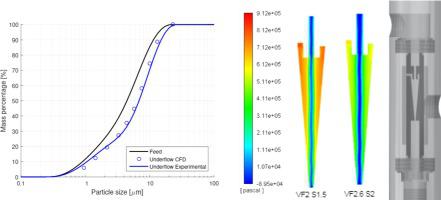Separation and Purification Technology ( IF 8.6 ) Pub Date : 2020-06-29 , DOI: 10.1016/j.seppur.2020.117253 D. Vega-Garcia , J.J. Cilliers , P.R. Brito-Parada

|
This work presents validated Computational Fluid Dynamics (CFD) predictions of the effect that changes in vortex finder and spigot diameters have on the classification performance of mini-hydrocyclones. Mini-hydrocyclones (e.g. 10 mm in diameter) have been applied successfully to the separation of micron-sized particles since their bypass fraction is larger than the water recovery, which results in a high particle recovery to the underflow, as well as low water recovery. However, a larger bypass fraction can be a disadvantage when the purpose of the hydrocyclone is particle classification, because of the large amount of fine particles that are misplaced in the underflow. Although it is well known that changes in the outlets of the hydrocyclone affect its performance, there is limited research on the effect of these design parameters in mini-hydrocyclones, in particular with regard to particle classification. The aim of this study is to computationally explore the influence of spigot and vortex finder on the classification process. To this end, CFD simulations were carried out and the predictions experimentally validated in a 3D printed mini-hydrocyclone using glass beads (below 20 μm) as the particulate system. The numerical results showed very good agreement with the experimental data for recovery of solids, concentration ratio, pressure drop and particle size distribution. A trade-off was observed between the solids recovery and concentration ratio, while the solids recovery was found to be inversely proportional to the pressure drop when vortex finder diameters were kept constant. It was found that the design that yielded the lowest recovery among those tested also resulted in a particle size distribution furthest away from that of the feed. We show how the model can be used to assess changes in design parameters in order to inform the selection of designs that exhibit lower energy requirements without compromising separation performance.
中文翻译:

小型水力旋流器中颗粒分类的CFD建模
这项工作提出了经过验证的计算流体动力学(CFD)预测,该预测预测了涡流探测器和插口直径的变化对小型水力旋流器的分类性能的影响。小型水力旋流器(例如直径为10毫米)已成功应用于微米级颗粒的分离,因为它们的旁通比大于水的回收率,这导致较高的颗粒回收率,以及较低的水回收率。然而,当水力旋流器的目的是颗粒分类时,较大的旁路分数可能是不利的,因为大量的细小颗粒在底流中放错了位置。尽管众所周知,水力旋流器出口的变化会影响其性能,这些设计参数在微型水力旋流器中的效果研究有限,特别是在颗粒分类方面。这项研究的目的是在计算上探索插口和涡流探测器对分类过程的影响。为此,进行了CFD模拟,并使用玻璃珠(小于20μm)作为微粒系统,在3D打印的微型水力旋流器中对预测进行了实验验证。数值结果与固体回收率,浓度比,压降和粒度分布的实验数据非常吻合。观察到了固形物回收率与浓度比之间的权衡,而当涡流探测器直径保持恒定时,固形物回收率与压降成反比。发现在所测试的产品中回收率最低的设计还导致粒度分布距进料的分布最远。我们展示了如何将模型用于评估设计参数的变化,以便在不影响分离性能的情况下,选择具有较低能耗要求的设计。


























 京公网安备 11010802027423号
京公网安备 11010802027423号